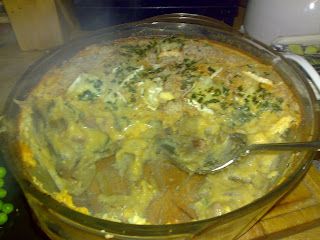
Last week, for reasons best known to herself, Jo proudly presented me with An Obscene Vegetable. This vegetable (if, indeed, it was actually a vegetable) was about a foot long, rounded and about 2 inches thick, and a lovely pale green colour all over, rather like a slim, pale marrow. At least, the marrow is the safest description we could come up with....
This Thing turned out to be a Dudhi, although knowing this did not really shed light on what to do with it. According to the shopkeeper, Dudhis go well in curries. This remains to be seen, since when I finally got round to cooking it, (as opposed to staring at it in the fridge nervously, waiting for inspiration to hit) I wasn't brave enough to add it to pilau or fry it up in spices or marinate it.
Instead, I created Dudhi Pie. This was a recipe invented on the spot, and as such, whatever I did to the Dudhi, I could always pretend it was supposed to be like that and get away with it. At an educated guess, I assumed the Dudhi was some sort of squash, so I put it with courgette, potato and plenty of cheese. I also made a herby eggy mixture with nutmeg and tarragon, and poured it over the top so the whole thing resembled quiche. I topped it with toasted breadcrumbs and slabs of brie. I had no idea if any of those ingredients and flavours suited a Dudhi, but it looked vaguely appetizing.
I did not even know if I was supposed to peel this thing. I brutally chopped its end off, and found it to be exactly the same colour inside as it was outside - the pale, pastel green. I peeled half of it experimentally, anyway. and found that I was just scraping off strips of green. It was indeed very squash like, but not actually squashy, the flesh is firm. Also, there were no seeds inside like a marrow or pumpkin. It smelled very fresh, like cut grass almost. If anything can smell "green" then this is it.
I cooked my Dudhi pie for around half an hour until the egg had solidified and the top browned. As pies go, it was a little on the heavy side - I think it would work as a cheesey quiche, and doesn't need the potato. But the Dudhi did make it a little different from average baked squash dishes. It has a delicate, almost nutty flavour, a little bitter and very 'summery', and it worked very well with nutmeg and the brie. It is nicely savoury and to my mind, (and my husband's) the whole thing tasted like it ought to be good for you. Overall, a success, methinks.
Unfortunately, Jo was not around that night to try the Dudhi. However, I have half of it left; a vegetable as obscenely sized as that could not be consumed by the two of us in one sitting. So, assuming it doesn't go off in the fridge (though quite how you'd tell is beyond me), I shall endevour to curry this strange object. Results to follow! I hope Jo continues to surprise me with Odd Vegetable matter. They are useful excuses to experiment in cooking, and hopefully my eccentric friends will be able to sample these experiments next time!











